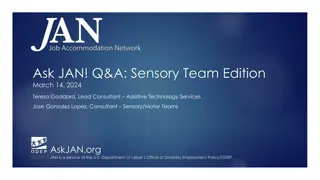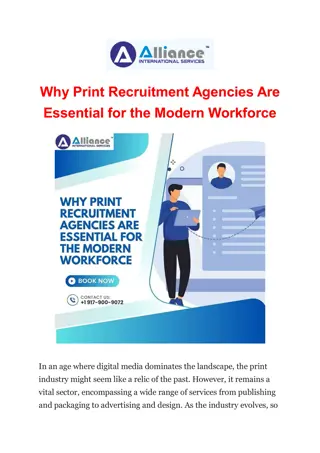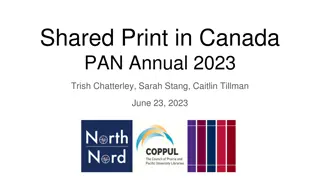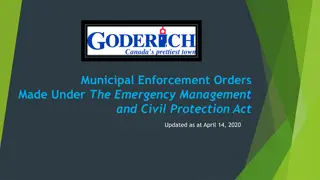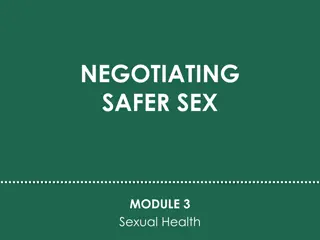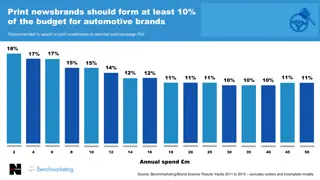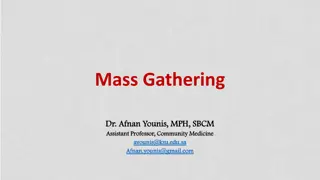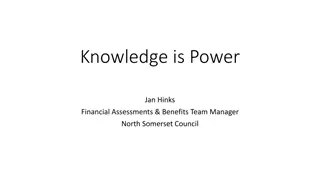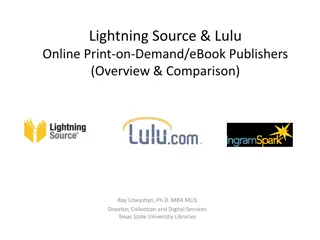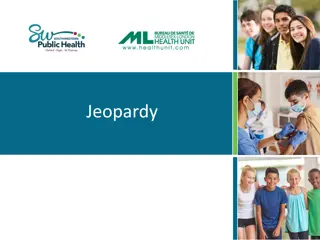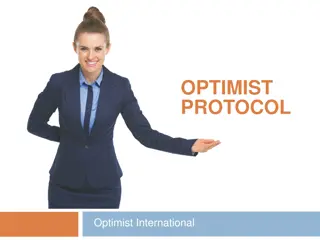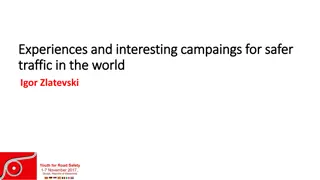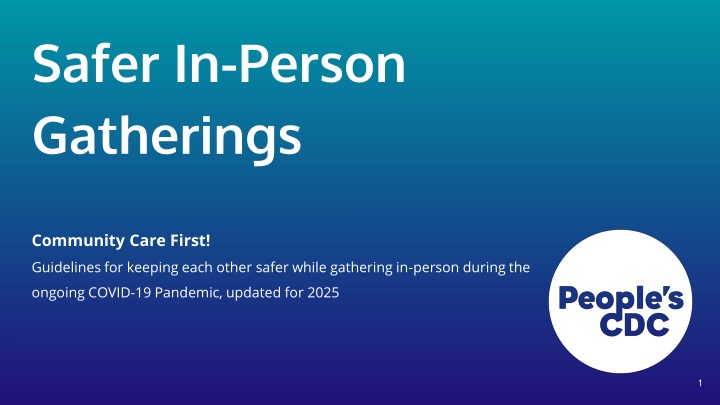
Safer In-Person Gatherings: Guidelines for COVID Safety 2025
Explore updated guidelines for safer in-person gatherings during the ongoing COVID-19 pandemic in 2025. Learn strategies to keep each other safe, including virtual options for inclusivity and ways to create a COVID-safer environment. Stay informed and prioritize community care.
Download Presentation

Please find below an Image/Link to download the presentation.
The content on the website is provided AS IS for your information and personal use only. It may not be sold, licensed, or shared on other websites without obtaining consent from the author. If you encounter any issues during the download, it is possible that the publisher has removed the file from their server.
You are allowed to download the files provided on this website for personal or commercial use, subject to the condition that they are used lawfully. All files are the property of their respective owners.
The content on the website is provided AS IS for your information and personal use only. It may not be sold, licensed, or shared on other websites without obtaining consent from the author.
E N D
Presentation Transcript
Safer In-Person Gatherings Community Care First! Guidelines for keeping each other safer while gathering in-person during the ongoing COVID-19 Pandemic, updated for 2025 1
Disclaimer: The information shared here is intended for educational, public health, and health advocacy purposes. It is not a substitute for individual medical advice. 2
Table of Contents: 1. Background on the Guide 2. Safer Gatherings: Before the Event, During the Event, and After the Event 3. Questions and Special Scenarios 4. The Political Landscape: Background on the Ongoing Need for Layered Protections 5. How to Stay Informed 6. Glossary 7. References 3
We Owe It to Each Other to Create Safe and Accessible Spaces This guide offers strategies for safer in-person gatherings. We must remember that sometimes the safest and most accessible way of gathering is joining online. Providing and demanding substantive remote options for participation in events, conferences, and protests and strategies for meaningful participation can ensure equitable access for those who are avoiding COVID infections (as well as other access needs). 4
Solidarity Means We Protect Each Other COVID-19 is spread by tiny particles that stay in the air when people talk, cough, breathe, or sing.1We all share air, especially in indoor spaces. We can and must make gatherings safer for EVERYONE. This guide will introduce you to the multiple safety strategies, which when combined or layered on top of each other can create a safer environment than any single strategy can on its own. The guide has been made with organizers in mind. We hope it helps you create COVID- safer workplace environments, schools, conferences, organizing meetings, film screenings, and cultural events. The same principles can inform smaller gatherings as well. At the end of this guide, we invite you to read background on the ongoing need for COVID protection, which provides additional context and references that may be helpful in advocating for COVID protections at gatherings and in your community. 5
How to Use this Guide This guide is meant to contain practical suggestions for using masking and multiple protections to plan safer events. Here are some tips as you navigate the guide: Masking is a key protection. Other layers of protection should not be seen as a substitute for masking. Use as many layers together as you can to reduce the risk of spreading COVID at and after your event. Layers of protection can be adapted to the needs of your group and the purpose of the event. Not all layers may be practical or available depending on local resources and the type of event. We must organize to demand improved access to all layers of protection. 6
Checklist for Using Layers of Protection: Before, During, and After Your Safer Gathering Before the event Mask indoors prior to the event Universal pre-event testing Check for symptoms & exposure Plan substantive online options During the event Universal masking Proof of vaccination Gather outdoors Improve indoor air quality De-densify spaces Divide into small, consistent groups After the event Test, monitor & contact trace Evaluate protections and resources 7
Mask and Minimize Indoor Activities Five (5) Days Before the Event Explanation People can be contagious before they develop symptoms or test positive, and many people do not have symptoms with a COVID infection.2 4 Wearing a mask5,6and minimizing the number of people an attendee shares air with for at least 5 days prior to the event reduces the chance that an attendee may be contagious during the event. Individual infections show a variable amount of time between exposure and developing symptoms or testing positive.7,8 Recommendation Ask attendees to wear well-fitting respirator masks (N95/KN95/KF94) in all indoor spaces outside of their homes and when sharing air with people outside of their household for 5 days prior to the event. Provide respirators ahead of time and/or share local resources to get masks such as local Mask Blocs. 9
Require Pre-Event Testing: General Recommendations Explanation Testing can help reduce COVID spread through early detection and isolation. People without symptoms can spread COVID.2 4 There are three main types of tests: lab-based polymerase chain reaction (PCR) tests, home nucleic acid amplification tests (NAATs), and rapid antigen tests (RATs) General Recommendations Closely follow the manufacturer s kit instructions for the tests that are used. People who test positive (by any test) should stay home. People with known, unmasked exposure to those with COVID infections within the 5 days prior should stay home. People recovering from COVID should isolate appropriately (at least 7-10 days) and test negative twice at least 24 hours apart prior to the event.9,10 Organizers should offer assistance to people who may need help with understanding test results and/or who may need help making alternate plans. Even if using PCR or NAAT testing, masking and other layers of protection should still be used. 10
Require Pre-Event Testing: PCR Tests Lab based PCR tests detect viral RNA. PCR tests are the most sensitive at picking up COVID infections, meaning that they detect smaller amounts of virus which can lead to detection earlier in an infection or without symptoms. In most US cities, lab-based PCR tests are no longer free nor readily available. When they are available, there is often a long delay before results are available. Recommendations If using PCR tests, attendees should test negative as close to the event as possible, ideally within 48 hours of the event. People with known, unmasked exposure to those with COVID infections within the 5 days prior to the event should plan to attend virtually. People recovering from COVID should isolate appropriately (at least 7-10 days) and test negative twice at least 24 hours apart prior to the event.9,10 If your event is multiple days, we recommend repeating testing every 48 hours, although data suggests that twice-weekly PCR testing also decreases risk.11Of course, this protocol assumes same-day results. 11 We must continue to demand free, accessible, same-day PCR testing.12
Require Pre-Event Testing: At home NAAT Tests At home NAATs detect viral RNA through methods other than PCR (for example, LAMP). NAATs approved by the FDA13are less sensitive than lab-based PCR tests for a variety of reasons,14but are more sensitive than rapid antigen tests. Recommendations If using home NAAT, attendees should test negative the day of the event. People with known, unmasked exposure to those with COVID infections within the 5 days prior to the event should plan to attend virtually. People recovering from COVID should isolate appropriately (at least 7-10 days) and test negative twice at least 24 hours apart prior to the event.9,10 If your event is multiple days, we recommend daily testing. If someone tests positive, follow our guide. 12
Require Pre-Event Testing: Rapid Antigen Tests Rapid Antigen Tests (RATs) detect pieces of the COVID virus in the nose or mouth. These tests are less sensitive than PCR tests or home NAATs, meaning that RATs are more likely to miss infections compared to PCR or NAAT, especially in people who do not have symptoms.15 Someone who tests positive for COVID by a rapid antigen test is very likely to be contagious.16 Recommendations If using RAT, attendees should test the day prior to the event and also the day of the event. People should use a combined throat and nasal swab strategy to improve sensitivity.17,18 People with known, unmasked exposure to those with COVID infections within the 5 days prior to the event should plan to attend virtually. People recovering from COVID should isolate appropriately (at least 7-10 days) and test negative twice at least 24 hours apart prior to the event.9,10 For multiple day events, attendees should test daily. 13
Symptoms and Exposure Checklist Explanation Checking for symptoms and exposure can reduce the chances that people who have active infections19-21with COVID or other contagious diseases attend the event.7 COVID symptoms may be mild and vary from person-to-person.2 COVID-19 is typically infectious for between 7 and 10 days,7and infectiousness tends to peak around day 4 to 5 of symptoms.8 COVID symptoms are similar to other common conditions such as seasonal allergies. People who have new and unexplained symptoms may have other infectious diseases such as flu, RSV, or pertussis. It s still worth preventing their spread as well. 14
Symptoms and Exposure Checklist Recommendation Ask participants to complete a daily symptom and exposure checklist.22 If someone is experiencing any new infectious symptoms (including but not limited to the checklist above), they should stay home and seek individual medical advice, even if they have a negative COVID test. Advise attendees to leave the event if they develop symptoms. People recovering from COVID should isolate appropriately (at least 7-10 days) and test negative twice at least 24 hours apart prior to the event.9,10 Ensure that any necessary roles and activities have appropriate back-up coverage in case of illness. Offer the option of virtual attendance for all. 15
Plan Substantive Online Options Explanation Hybrid Options can be done well fairly inexpensively! Invest in or borrow an audio-video device that can track speakers voices and video and use a projector to bring the online participants into the room. This allows all participants online and in person - to see and hear each other adequately. Robust virtual options provide social connection and sharing of ideas. Virtual options can improve inclusion and disability access across a range of access needs.23 When possible, gatherings should be designed so that virtual and in person attendees can all meaningfully interact with both presenters and other attendees.23 Streaming or view-only online options are not ideal but may be better than no virtual access, depending on the purpose of the event. 16
Plan Substantive Online Options Recommendation Assign a point person or team for hybrid event support. Borrow or purchase a teleconferencing camera to improve remote access. Perform pre-event checks to ensure that in person and virtual attendees are receiving good sound and visual quality. Provide text captioning of audio content. Provide options for virtual attendees to interact with each other or with in person participants in small groups, formally or informally. Include both in person and virtual attendees in discussions and Q&A. 17
Universal N95/KN95/KF94 Masking Explanation Masking by all attendees/participants (universal masking) substantially reduces the risk of infection. Masks filter the air that wearers breathe out, making it less likely that an infected person wearing a mask will spread the infection to others.5 Masks also provide good protection to the wearer.5 One-way masking provides less protection that universal masking.5 We recommend universal masking with N95/KN95/KF94 masks24obtained from reputable sources (avoid Amazon, avoid counterfeits).6 Surgical masks provide less protection than N95/KN95/KF94 masks as they do not fit tightly. Cloth masks are the least protective option but are still better than not masking.6 19
Universal N95/KN95/KF94 Masking Recommendations Require all attendees to mask with well-fitting, high-filtration masks throughout the gathering. Obtain and distribute enough masks for all attendees, plus extras. Providing a couple of size and style options can help attendees obtain a good fit, such as a range of sizes and a mix of head strap and ear loop options. Distribute masks either before the event or at an outdoor entrance. Allow attendees to wear their own respirators if they are well-fitting Provide a resource on how to wear masks well, such as our masking guide.24 Oppose mask bans in your community.25 Advocate for free access to high-filtration masks for all from our governments, and find creative ways to supply them to our communities in the meantime, such as through local mask distribution efforts. 20
Require Proof of Vaccination Explanation Vaccination with the latest vaccines reduces the risk of COVID infection, as well as reducing the risk of severe disease and Long COVID.26 30 Vaccination policies protect attendees as well as protecting healthcare capacity within the community. Vaccinated people can spread COVID if they are infected, and vaccination should not be considered a substitute for masking. 21
Require Proof of Vaccination Recommendations Both adults and children (6 months and older) should provide proof of vaccination with the latest COVID vaccine formulations, within the last year. Remind attendees to get their updated vaccines at least two weeks in advance of the event so the vaccine has enough time to provide the best protection. Medical exemptions to the vaccination requirement are rare and should be allowed. Provide information on local resources for low-cost or no-cost vaccination for uninsured and underinsured adults and children. COVID vaccinations for uninsured/underinsured children are covered by the Vaccines for Children Program.31 22
Move Activities Outdoors Explanation In outdoor spaces, it is less likely that someone inhales someone else s exhaled air, so the odds of transmitting COVID in outdoor spaces is significantly less than in indoor spaces. Exercising,32singing, and shouting expel high levels of aerosols33and increase risk of transmission. Outdoor settings are lower risk, but transmission can still occur, especially in crowds and when there is not much of a breeze.34 23
Move Activities Outdoors Recommendations Gather outdoors whenever possible. If needed, use portable heaters and encourage layering. For primarily indoor gatherings, hold all meals, exercising, singing, and shouting activities outdoors. Ask people to distance more than six feet from those outside their household or consent-based group while unmasked. Plan for multiple weather conditions or select a rain date if needed. If you need to cover your outdoor gathering, maximize airflow using tents without sides. Use fans strategically to create cross ventilation for large, crowded tents. We continue to recommend requiring masks and distancing in crowded, outdoor spaces. 24
Improve Indoor Air Quality via Ventilation and Filtration Explanation Multiple strategies may be necessary to make the indoor air safer, depending on building setup and resources. Ventilation brings in outdoor air to dilute infectious aerosols and replace the air. Filtration removes potentially infectious aerosols from the air. CO2 monitoring is a way to estimate and monitor ventilation CO2monitoring is a way to estimate and monitor ventilation as CO2is higher in our exhaled breath than it is in outdoor air.35,36 Ventilation strategies that bring in outdoor air reduce CO2toward outdoor air levels. Air filtration alone makes air safer from infectious aerosols but does not remove CO2. 35,36 25
Improve Indoor Air Quality via Ventilation and Filtration Explanation For further information and detailed recommendations, refer to our resources, which apply to indoor spaces broadly (not just workplaces and schools): Ventilation for Coronavirus in the Workplace Ventilation for Coronavirus in the Workplace37 Ventilation for Coronavirus in Schools38 Consultation with the building s facilities maintenance staff in preparation for the event may be helpful in optimizing ventilation and filtration. Enhanced ventilation/filtration cannot address short-range spread of aerosols and is not a substitute for universal masking. Ventilation for Coronavirus in Schools 26
Improve Indoor Air Quality via Ventilation and Filtration Recommendations Ensure that HVAC systems are well-maintained and provide as much outdoor air as the system will safely allow. Upgrade HVAC filters to HEPA filters or ideally MERV13 or higher, where possible. Supplement HVAC systems with portable HEPA air purifiers (or, alternatively, DIY air filtering units). Multiple portable air purifiers may be used to increase filtration in larger or more crowded spaces. Ensure that these are kept running throughout the event. 27
Improve Indoor Air Quality via Ventilation and Filtration Recommendations When outdoor conditions permit, open doors and windows. Open windows on opposite walls if possible for cross ventilation. Simple fans in windows can improve airflow and cross ventilation. Plan placement so that there is both improved intake and exhaust. Plan to move higher aerosol-producing activities such as singing, exercising, or talking outdoors if possible. Minimize the duration of these activities if they are done indoors. If monitoring CO2during the event, levels as close to outdoor air (420-480 ppm CO2) as possible indicate better ventilation. Levels should not exceed 1000 ppm CO2. 28
Keep Groups Small and Consistent Explanation Keeping groups small and consistent reduces the number of potential contacts each person has, thus reducing potential exposures and making contact tracing more straightforward.39 This concept may also be called cohorting, podding, or bubbling. Recommendation For larger gatherings, divide participants into small groups or cohorts and maintain the same groups throughout the event. Consider keeping members of the same household together within groups. 29
Increase Distance and De-densify Spaces Explanation Increased distance between people reduces the risk of infection by providing more air-space for infectious aerosols to spread out before the air reaches others.40 Aerosols can spread much farther than 6 feet, and distance is most effectively used along with masking and other precautions. Recommendation Physical barriers, signs, and placement of seating and tables can help remind people to maintain spacing. Maximum occupancy of physical spaces should be estimated so that indoor and outdoor spaces do not become unnecessarily crowded. Gathering organizers may consider assigning someone to monitor spacing/occupancy and help direct crowds at key points in the gathering. 30
Post-Event Testing, Symptom Monitoring, & Contact Tracing Explanation Contact tracing helps prevent further onward spread of infectious diseases by notifying potentially exposed people, which allows them to quarantine before they may expose more people.41 Advance planning and organizer support can help reduce the stigma associated with reporting a positive test or symptoms after an event. 32
Post-Event Testing, Symptom Monitoring, & Contact Tracing Recommendation Remind participants to test twice, starting 5 days after the gathering or sooner if symptoms develop. Provide tests for this purpose. Ask participants to immediately report any development of symptoms or positive COVID test results that occur within the two weeks following the event. Meeting organizers should immediately inform anyone who may have been exposed to another participant who develops symptoms or who tests positive. Even if precautions were taken, anyone who may have shared air, especially indoors, should be considered a potential contact. 33
Post-event debrief: Evaluate precautions and resources, take action for the future Explanation A post-event debrief can help improve event planning for the future, identifying areas to improve procedures and resources. Recommendation If your group may be hosting additional safer in-person gatherings in the future, evaluating your approach within a few days after the event can help identify areas for improvement. Seek feedback from attendees including comments on what worked and what could be improved for accessibility and COVID precautions. Identify any difficulties with communication, precautions, or resources. Identify needs for funding such as improving HVAC systems or purchasing masks, tests, or HEPA air purifiers. Communicate any lessons learned to allies who may be planning similar events. Identify local resources and needs to support safer events in the future, and communicate those needs to leaders/elected officials who may be able to enact changes. 34
Use Multiple Layers of Protection. No one layer provides complete protection. We recommend incorporating as many layers of protection as you can. 35
Questions and Special Scenarios 36
Can events without universal masking requirements be considered safer events? Masking is a necessary element of a safer gathering as masks both protect the wearer and reduce infectious aerosols within the space. The other layers listed in this guide can help reduce risk but are not a substitute for masking. No other precaution or combination of precautions is a suitable substitute for masking. 37
How can organizers reduce risk if eating and drinking are necessary during the gathering? Provide outdoor spaces for eating and drinking. Communicate meal-time logistics ahead of time to attendees. Stagger eating shifts if space is limited. Seat people from the same household or pods together and use distancing between groups. Consider providing food packaged to take away at the end of the gathering. Ensure that masks are worn whenever food and drink are not actively being consumed. 38
The Political Landscape: Background on the Ongoing Need for Layered Protections 39
Letting a Harmful Infectious Disease Spread Unchecked is a Dangerous Policy Decision From the start of the pandemic, the policy response from both the Trump and Biden administration was inadequate: confusing, inconsistent, and prioritizing commerce over saving people s lives. Still, popular pressure helped produce the 2020 (CARES Act), a set of policies amounting to the largest ever expansion of the US public safety net. These popular measures effectively increased human welfare indicators and included expanded healthcare access, Medicaid expansion, extended unemployment benefits, paid sick leave, child tax credits, free PCR testing, and free vaccines. Upon taking office in 2021, Biden s CDC and a Democratic-controlled Congress incrementally eliminated public health protective measures, rapidly bowing to corporate pressure to get people back to work, travel and shopping. While Biden s CDC eliminated mask mandates recommendations in essential public spaces, isolation recommendations and data tracking and reporting, the incoming Trump administrations will likely attack mask-wearing, vaccine access and infection control further. We all need to imagine and demand the robust public health infrastructure we all deserve, while keeping each other safer. 40
Vaccination is Essential, and Insufficient Alone. Vaccination with the latest updated vaccine boosters continues to be foundational to a multilayered approach to COVID prevention, reducing the risk of both severe disease29and Long COVID.30Far too few Americans have received the latest vaccines. COVID vaccination rates in both adults and children lag far behind influenza vaccination rates. As of December 7, 2024, only 21% of adults had received the latest 2024-2025 COVID vaccine,42while 40.8% had received the seasonal influenza vaccine.43Only 10.6% of children had received the 2024-2025 COVID vaccine,42 while 40.8% of children had received the seasonal influenza vaccine.43 Vaccine efficacy wanes significantly beginning about four months following vaccination,28,44,45 making updated vaccination along with masking and multilayered precautions important for all people as COVID continues to spread in our communities. In January 2024, Congress failed to approve $6.1 billion in COVID spending46that would have prolonged the program that provided vaccines, including the COVID vaccine, for uninsured Americans. The US Government continues to prioritize militarization over essential public health resources and infrastructure. 41
COVID Continues to Cause Death, Severe Disease, and Chronic Illness Both adults and children face risks of serious disease from COVID infections.30,47,48COVID vaccination and treatment reduce but do not eliminate the risk of severe outcomes and long-term disability.49 51Both vaccination and treatment are underutilized42,52and inadequately accessible. Repeated COVID infections pose increased health risks.50,53In provisional data from 2023, COVID was the 10th leading cause of death in the US, and the only specific infectious disease cause of death listed.54 COVID continues to disproportionately impact elderly, immunocompromised, and disabled people as well as Black, Latine and Indigenous communities, and the Global South, exacerbating existing health inequities.55 42
We All Deserve a Robust Public Health Infrastructure The best way to avoid COVID s harmful impacts and Long COVID is to avoid infection in the first place. The People s CDC provides up to date, scientifically-vetted information on how to stay safer. But we need governments and elected officials that prioritize our health. While using this guide to reduce risk at your events it is also essential to build public health priorities into our organizing. We must demand public policy that protects people from harmful infectious diseases, from ongoing pandemics, and from pandemics which continue to emerge with unmitigated climate change. Keeping one another safe and healthy is essential to any liberatory vision. We owe it to each other to demand robust public health infrastructure policies at all levels of government from town, city and tribe to state to federal. 43
How to Stay Informed This guide was compiled by the People's CDC. We are a CDC watchdog organization, and a health justice advocacy organization. Subscribe for free on Substack to receive our Weekly Weather Report and alerts on Action Campaigns in your inbox. For additional resources, visit our resources page. 44
GLOSSARY Aerosol: Tiny, invisible particles in the air that can contain COVID and other diseases that spread through the respiratory tract. Aerosols are produced by breathing, talking, singing, coughing, or sneezing. Incubation Period: The time between exposure to an infectious agent and development of symptoms. Universal: Something all in person attendees must do. Universal Masking: All attendees (including presenters) wear well-fitting respirator masks, providing both source control and protection for the wearer. Universal Pre-Event Testing: All attendees test prior to the event and stay home if they test positive. NIOSH: The National Institute for Occupational Safety and Health (https://www.cdc.gov/niosh/index.html) is the US agency that approves N95 respirator masks, which are effective in reducing the risk of COVID. N95: The US-standard for high filtration respirators that filters at least 95% of aerosols. https://www.cdc.gov/niosh/npptl/topics/respirators/disp_part/default.html https://peoplescdc.org/2022/09/12/masking/ KN95: An Chinese standard for high filtration respirators, which may have ear loops or head straps. https://peoplescdc.org/2022/09/12/masking/ KF94: A South Korean standard for high filtration respirators, which may have ear loops or head straps. https://peoplescdc.org/2022/09/12/masking/ 45
References, slide 1 of 2 1. Greenhalgh T, Jimenez J, Prather K, Tufekci Z, Fisman D, Schooly R. Ten scientific reasons in support of airborne transmission of SARS-CoV-2. The Lancet. 2021;397(10285):1602-1605. doi:10.1016/S0140- 6736(21)00869-2 Yu W, Guo Y, Zhang S, Kong Y, Shen Z, Zhang J. Proportion of asymptomatic infection and nonsevere disease caused by SARS CoV 2 Omicron variant: A systematic review and analysis. J Med Virol. 2022;94(12):5790- 5801. doi:10.1002/jmv.28066 Johansson MA, Quandelacy TM, Kada S, et al. SARS-CoV-2 Transmission From People Without COVID-19 Symptoms. JAMA Netw Open. 2021;4(1):e2035057. doi:10.1001/jamanetworkopen.2020.35057 doi:10.1001/jamanetworkopen.2020.35057 Funk A, Florin TA, Kuppermann N, et al. Household Transmission Dynamics of Asymptomatic SARS-CoV-2 Infected Children: A Multinational, Controlled Case-Ascertained Prospective Study. Clin Infect Dis. Published online March 26, 2024:ciae069. doi:10.1093/cid/ciae069 Bagheri G, Thiede B, Hejazi B, Bodenschatz E. An upper bound on one-to-one exposure to infectious human respiratory particles. PNAS. 118(49). doi:https://doi.org/10.1073/pnas.2110117118 https://doi.org/10.1073/pnas.2110117118 Andrejko KL. Effectiveness of Face Mask or Respirator Use in Indoor Public Settings for Prevention of SARS-CoV-2 Infection California, February December 2021. MMWR Morb Mortal Wkly Rep. 2022;71. doi:10.15585/mmwr.mm7106e1 Puhach O, Meyer B, Eckerle I. SARS-CoV-2 viral load and shedding kinetics. Nat Rev Microbiol. 2023;21(3):147-161. doi:10.1038/s41579-022-00822-w Frediani JK, Parsons R, McLendon KB, et al. The New Normal: Delayed Peak SARS-CoV-2 Viral Loads Relative to Symptom Onset and Implications for COVID-19 Testing Programs. Clin Infect Dis. 2024;78(2):301-307. doi:10.1093/cid/ciad582 COVID Isolation Expert Sign On Letter. People s CDC. April 10, 2024. Accessed November 24, 2024. https://peoplescdc.org/2024/04/10/covid-isolation-expert-sign-on-letter/ 10. What to Do if You Have COVID. People s CDC. January 10, 2023. Accessed December 21, 2024. https://peoplescdc.org/2023/01/10/what-to-do-if-you-have-covid/ 11. Bilinski A, Ciaranello A, Fitzpatrick MC, et al. Estimated Transmission Outcomes and Costs of SARS-CoV-2 Diagnostic Testing, Screening, and Surveillance Strategies Among a Simulated Population of Primary School Students. JAMA Pediatr. 2022;176(7):679-689. doi:10.1001/jamapediatrics.2022.1326 12. Network. Free PCR For All. Accessed December 11, 2024. https://actionnetwork.org/letters/free-pcr-for-all 13. Health C for D and R. In Vitro Diagnostics EUAs - Molecular Diagnostic Tests for SARS-CoV-2. FDA. Published online November 19, 2024. Accessed November 24, 2024. https://www.fda.gov/medical-devices/covid-19- emergency-use-authorizations-medical-devices/in-vitro-diagnostics-euas-molecular-diagnostic-tests-sars-cov-2 14. Smy L, Ledeboer NA, Wood MG. At-home testing for respiratory viruses: a minireview of the current landscape. J Clin Microbiol. 2024;62(5):e00312-23. doi:10.1128/jcm.00312-23 15. Smith-Jeffcoat SE. SARS-CoV-2 Viral Shedding and Rapid Antigen Test Performance Respiratory Virus Transmission Network, November 2022 May 2023. MMWR Morb Mortal Wkly Rep. 2024;73. doi:10.15585/mmwr.mm7316a2 16. Kirby JE, Riedel S, Dutta S, et al. Sars-Cov-2 antigen tests predict infectivity based on viral culture: comparison of antigen, PCR viral load, and viral culture testing on a large sample cohort. Clin Microbiol Infect Off Publ Eur Soc Clin Microbiol Infect Dis. 2023;29(1):94-100. doi:10.1016/j.cmi.2022.07.010 17. Goodall BL, LeBlanc JJ, Hatchette TF, Barrett L, Patriquin G. Investigating the Sensitivity of Nasal or Throat Swabs: Combination of Both Swabs Increases the Sensitivity of SARS-CoV-2 Rapid Antigen Tests. Microbiol Spectr. 2022;10(4):e0021722. doi:10.1128/spectrum.00217-22 18. COVID-19 Rapid Antigen Tests: How to Collect a Sample. Accessed November 24, 2024. https://www.ontariohealth.ca/sites/ontariohealth/files/2022-02/COVID-19RapidAntigenTests-HowtoCollectaSample.pdf 19. Matthews ZK, Cybulski DJ, Frankel DN, et al. Sensitivity of Symptom-Based Screening for COVID-19 in Active Duty Basic Trainees. Mil Med. 2024;189(5-6):1196-1200. doi:10.1093/milmed/usad138 20. Keck JW, Bush M, Razick R, Mohammadie S, Musalia J, Hamm J. Performance of formal smell testing and symptom screening for identifying SARS-CoV-2 infection. PloS One. 2022;17(4):e0266912. doi:10.1371/journal.pone.0266912 21. Smith DS, Richey EA, Brunetto WL. A Symptom-Based Rule for Diagnosis of COVID-19. SN Compr Clin Med. 2020;2(11):1947-1954. doi:10.1007/s42399-020-00603-7 22. Sample Employee COVID-19 Health Screening Questionnaire. Accessed November 30, 2024.https://www.osha.gov/sites/default/files/publications/OSHA4132.pdf 23. Joo R, S nchez-Tapia A, Mortara S, et al. Ten simple rules to host an inclusive conference. PLoS Comput Biol. 2022;18(7):e1010164. doi:10.1371/journal.pcbi.1010164 24. Masking. People s CDC. September 12, 2022. Accessed December 8, 2024. https://peoplescdc.org/2022/09/12/masking/ 25. No Mask Bans. People s CDC. June 18, 2024. Accessed December 8, 2024. https://peoplescdc.org/2024/06/18/no-mask-bans/ 26. Link-Gelles R. Effectiveness of COVID-19 (2023-2024 Formula) vaccines. https://www.fda.gov/media/179140/download 2. 3. 4. 5. 6. 7. 8. 9. 46
References, slide 2 of 2 27. Wu N, Joyal-Desmarais K, Vieira AM, et al. COVID-19 boosters versus primary series: update to a living review. Lancet Respir Med. 2023;11(10):e87-e88. doi:10.1016/S2213-2600(23)00265-5 28. Menegale F, Manica M, Zardini A, et al. Evaluation of Waning of SARS-CoV-2 Vaccine Induced Immunity: A Systematic Review and Meta-analysis. JAMA Netw Open. 2023;6(5):e2310650. doi:10.1001/jamanetworkopen.2023.10650 29. Yousaf AR. Notes from the Field: Surveillance for Multisystem Inflammatory Syndrome in Children United States, 2023. MMWR Morb Mortal Wkly Rep. 2024;73. doi:10.15585/mmwr.mm7310a2 30. Fang Z, Ahrnsbrak R, Rekito A. Evidence Mounts That About 7% of US Adults Have Had Long COVID. JAMA. Published online June 7, 2024. doi:10.1001/jama.2024.11370 31. CDC. Vaccines for Children (VFC) Program: Information for Parents. Vaccines for Children Program. September 25, 2024. Accessed December 8, 2024. https://www.cdc.gov/vaccines-for-children/vfc-information-for- parents/index.html 32. Cowie B, Wadlow I, Yule A, et al. Aerosol Generation During High Intensity Exercise Implications for COVID-19 Transmission. Heart Lung Circ. 2023;32(1):67-78. doi:10.1016/j.hlc.2022.10.014 33. Archer J, McCarthy LP, Symons HE, et al. Comparing aerosol number and mass exhalation rates from children and adults during breathing, speaking and singing. Interface Focus. 2022;12(2):20210078. doi:10.1098/rsfs.2021.0078 34. Bulfone TC, Malekinejad M, Rutherford GW, Razani N. Outdoor Transmission of SARS-CoV-2 and Other Respiratory Viruses: A Systematic Review. J Infect Dis. 2021;223(4):550-561. doi:10.1093/infdis/jiaa742 35. Association NE. How to Evaluate Building Ventilation Using Carbon Dioxide Monitors | NEA. Accessed December 11, 2024. https://www.nea.org/resource-library/how-evaluate-building-ventilation-using-carbon- dioxide-monitors 36. CDC P. CO2 Monitoring of Ventilation. People s CDC. February 12, 2023. Accessed December 11, 2024. https://peoplescdc.org/2023/02/12/co2-monitoring-of-ventilation/ 37. CDC P. Ventilation for Coronavirus in the Workplace. People s CDC. September 23, 2022. Accessed December 11, 2024. https://peoplescdc.org/2022/09/23/ventilation-for-coronavirus-in-the-workplace/ 38. Ventilation for Coronavirus in Schools | People s CDC. Accessed December 11, 2024. https://peoplescdc.org/2022/09/23/ventilation-for-coronavirus-in-schools/ 39. Block P, Hoffman M, Raabe IJ, et al. Social network-based distancing strategies to flatten the COVID-19 curve in a post-lockdown world. Nat Hum Behav. 2020;4(6):588-596. doi:10.1038/s41562-020-0898-6 40. Wang C, Prather K, Marr L. Airborne transmission of respiratory viruses. Science. 2021;373(6558). doi:https://doi.org/10.1126/science.abd9149 41. David J. Sencer CDC Museum Public Health Academy. Contact Tracing. Accessed December 11, 2024. https://www.cdc.gov/museum/pdf/cdcm-pha-stem-lesson-contact-tracing-lesson.pdf 42. CDC. Weekly COVID-19 Vaccination Dashboard. COVIDVaxView. December 17, 2024. Accessed December 21, 2024. https://www.cdc.gov/covidvaxview/weekly-dashboard/index.html 43. CDC. Weekly Flu Vaccination Dashboard. FluVaxView. December 17, 2024. Accessed December 21, 2024. https://www.cdc.gov/fluvaxview/dashboard/index.html 44. Wu N, Joyal-Desmarais K, Vieira AM, et al. COVID-19 boosters versus primary series: update to a living review. Lancet Respir Med. 2023;11(10):e87-e88. doi:10.1016/S2213-2600(23)00265-5 45. Link-Gelles R. COVID-19 vaccine effectiveness updates. Presented at: FDA VRBPAC Meeting; June 15, 2023. Accessed February 9, 2024. https://www.fda.gov/media/169536/download 46. Congress reaches a deal on how much to spend for 2024 as shutdown deadline nears. NBC News. January 7, 2024. Accessed December 21, 2024. https://www.nbcnews.com/politics/congress/congress-reaches- deal-much-spend-2024-shutdown-deadline-nears-rcna132739 47. Rao S, Gross RS, Mohandas S, et al. Postacute Sequelae of SARS-CoV-2 in Children. Pediatrics. 2024;153(3):e2023062570. doi:10.1542/peds.2023-062570 48. Xie Y, Xu E, Bowe B, Al-Aly Z. Long-term cardiovascular outcomes of COVID-19. Nat Med. 2022;28:583-590. https://doi.org/10.1038/s41591-022-01689-3 49. Razzaghi H, Forrest CB, Hirabayashi K, et al. Vaccine Effectiveness Against Long COVID in Children. Pediatrics. Published online March 8, 2024:e2023064446. doi:10.1542/peds.2023-064446 50. Thaweethai T, Jolley SE, Karlson EW, et al. Development of a Definition of Postacute Sequelae of SARS-CoV-2 Infection. JAMA. Published online May 25, 2023. doi:10.1001/jama.2023.8823 51. Amani B, Akbarzadeh A, Amani B, et al. Comparative efficacy and safety of nirmatrelvir/ritonavir and molnupiravir for COVID-19: A systematic review and meta-analysis. J Med Virol. 2023;95(6):e28889. doi:10.1002/jmv.28889 52. Levy ME, Burrows E, Chilunda V, et al. Severe Acute Respiratory Syndrome Coronavirus 2 (SARS-CoV-2) Antiviral Prescribing Gaps Among Nonhospitalized High-Risk Adults. Clin Infect Dis. Published online January 3, 2024:ciad796. doi:10.1093/cid/ciad796 53. Al-Aly Z, Bowe B, Xie Y. Acute and postacute sequelae associated with SARS-CoV-2 reinfection. Nat Med. 2022;28:2398-2405. doi:10.1038/s41591-022-02051-3 54. Ahmad FB. Mortality in the United States Provisional Data, 2023. MMWR Morb Mortal Wkly Rep. 2024;73. doi:10.15585/mmwr.mm7331a1 55. Jirmanus L, Valenti R, Schwartzman EG, et al. Too Many Deaths, Too Many Left Behind: A People s External Review of the U.S. Centers for Disease Control and Prevention s COVID-19 Pandemic Response. AJPM Focus. Published online February 24, 2024.doi:10.1016/j.focus.2024.100207 47


